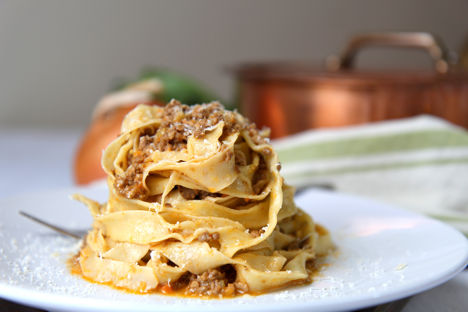
10 of the best pasta and sauce pairings
The Italians know the shape of a pasta is about much more than just looks – every different strand, shell, sheet and tube works best in a particular dish. Take a look at some of the most popular pasta varieties and see which sauces you should be serving them with.
10 of the best pasta and sauce pairings
The Italians know the shape of a pasta is about much more than just looks – every different strand, shell, sheet and tube works best in a particular dish. Take a look at some of the most popular pasta varieties and see which sauces you should be serving them with.
There are over 300 shapes of pasta produced in Italy, dozens of which now line the shelves of supermarkets and delis in the UK. While we wouldn’t use lasagne sheets in a carbonara and know cannelloni are best baked rather than boiled, when it comes to varieties such as farfalle, penne rigate and linguine we often use them interchangeably with all sorts of different pasta sauces.
This is certainly not the case in Italy. For one thing, certain pasta shapes are associated with specific regions, and the average Italian nonna knows that farfalle can drown in a thick ragù while a smooth tomato sauce simply doesn’t sit right with a bowl of tortiglioni. If you’re wondering what to serve with a nice plate of conchiglie, read on to see which sauces pair perfectly with some of the most popular pasta varieties in the UK today.
Cannelloni
These large tubes are designed to be filled and then baked, so there needs to be enough liquid to soften the pasta but a filling chunky enough to hold its shape within the cannelloni. Typical fillings include a thick mousse of spinach and ricotta or something chunkier, such as minced beef with egg, Parmesan and ricotta.
Conchiglie
Shell-shaped and open, conchiglie works well with tomato-based sauces and the fact that each piece has a large cavity means it can catch chunkier or heavier sauces inside, holding lots of liquid and trapping small pieces of ingredients. Sauces such as puttanesca are perfect, as capers will easily find their way into the shells.
Farfalle
Based on the shape of butterflies, farfalle is usually enjoyed in the summer with lots of fresh, seasonal vegetables. The pinched centre helps them catch a small amount of sauce, but make sure they’re not too heavy or claggy. Because of their attractive shape, they are also popular in salads, lightly dressed with olive oil.
Fusilli
This twisted pasta has lots of intertwining layers that are perfect at catching sauce, particularly smoother ones that will happily cling to each piece. Pesto and arrabbiata go particularly well, while the chewy, robust texture of fusilli means it’s also a good addition to salads.
Lasagne
These pasta sheets have one obvious use as the filling layers in a lasagne, but the sauce used doesn’t have to be ragù-based. Vegetable sauces work just as well provided they contain enough liquid to soften the sheets, and some Italian regions (such as Veneto) are home to sweet festive dishes made using lasagne sheets, apples, raisins, butter and sugar. Some sheets need pre-boiling for use, but others such as Barilla's are ready to layer and place straight in the oven.
Linguine
Similar to spaghetti but with a slightly flattened elliptical shape, linguine can catch a little more sauce and folds in a similar way to tagliatelle. Best with smooth and light seafood- and tomato-based sauces, it’s important the sauce is loose enough to help lubricate each strand and prevent them sticking together. The classic linguine alla vongole is the perfect example of this, with nothing more than white wine and olive to help create the sauce for the clams.
Penne rigate
Rigate refers to the ridges found on the exterior of this tubular pasta, which help sauce cling to each piece. The angled ends also help suck sauce up into the centre, making penne perfect with almost every type of sauce, particularly heavy or chunky ones that contain lots of ingredients. Because they can also be baked in sauce, penne is arguably the most versatile pasta shape out there.
Spaghetti
The most famous pasta shape in the world is also one of the most versatile. As long as there’s enough oil in the sauce to keep each strand slippery and separate, spaghetti will pair with lots of different sauces, although it is best suited to smoother, lighter ones such as pesto or a simple tomato and basil sauce.
Tagliatelle
These long wide ribbons can stand up to incredibly rich, heavy and robust sauces thanks to their larger surface area. As the original pasta shape used for Bolognese sauce, tagliatelle also works very well with thicker, creamier sauces, as it’s particularly adept at absorbing and picking them up.
Tortiglioni
Deep grooves and wide hollow centres mean very chunky sauces work best with this pasta. Sausage, lentils and other hearty ingredients can be served with tortiglioni, as can whole olives or particularly thick ragùs.


